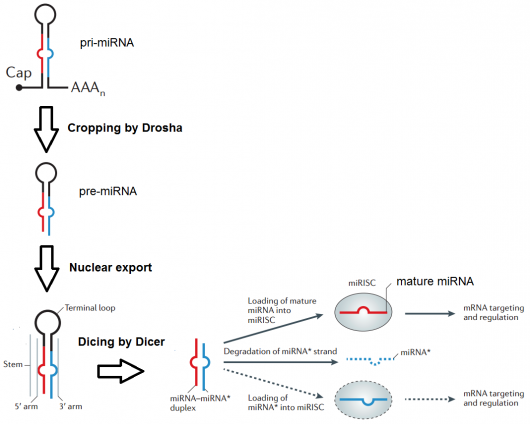How could microRNA have evolved to have such similar structure and function in plants and animals after evolving independently? You must be thinking, “What are the odds?!”
If evolution boiled down to nothing but random chance, the odds seem staggering indeed. No, I’m not about to say God guided evolution. What happens is there are certain traits about the system that constrain it to act in a certain way, making similar outcomes more likely.
To understand more fully, I have to teach you a little bit about microRNA biogenesis. Awww yeeeaaah!
Adapted from Berezikov 2011
In animals, a microRNA gene is transcribed to make what’s called “primary microRNA.” This pri-microRNA forms a hairpin structure – that is, it folds over and complementarily base-pairs to itself, forming a step and loop. This pri-microRNA is trimmed by the protein Drosha and is then shipped out of the nucleus as an ~80 nucleotide precursor microRNA. In the cytoplasm, the protein Dicer cleaves the pre-microRNA to form the mature ~22 nucleotide microRNA, which will go on to be involved in gene regulation.
In plants, pri-microRNA still forms hairpins, but their size can be far more variable. Plants also lack Drosha – all of the processing is done by a Dicer homologue.
You’re probably thinking, “So they’re processed differently. This doesn’t really convince me of the odds.” But what’s important to notice is that both of these systems share a couple of key things, which make convergent evolution more likely:
- Both use the protein Dicer to process mature microRNA. This is thought to be an exaptation – where a trait initially evolved to have one function, but has subsequently come to have another. Dicer is thought to initially be used to cleave foreign RNA particles, for example from viruses. There’s also evidence that suggests Dicer plays a role in repairing double stranded breaks in DNA. Since Dicer was already present in plants and animals because of these more ancestral functions, it was available in both lineages to be used for something else. Plants and animals didn’t have to evolve a totally new protein to process microRNA – they used the machinery they already had sitting around.
- Both process microRNA from hairpins. RNA hairpins spontaneously occur all the time, and some of these spontaneous hairpins give rise to new microRNA. That’s because if a hairpin happens to process into a mature microRNA that conveys a fitness advantage to an organism, natural selection will act to perpetuate it. If a hairpin results in an unfavorable outcome like disease, purifying selection will purge it from the population. Because RNA hairpins spontaneously occur and Dicer was already around, natural selection would act favorably on a system where processing hairpins leads to a fitness benefit.

This is post 9 of 49 of Blogathon. Donate to the Secular Student Alliance here.


Totally agree. Evolution Rocks. :-)